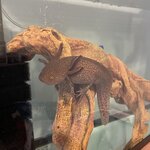kaypluslee
New member
I apologize in advance for the length of this post but I have two months of readings and updates to get through so bear with me and I appreciate any advice offered.
I do have a poor 6 month old axolotl, Quinoa, who has been tubbed for a large chunk of this ordeal. Quinoa’s in a tub with an air stone, daily water changes, temperature kept between 58-64 degrees Fahrenheit (normally around 60-61) through use of frozen water bottles on either side of tub or a desk fan. Quinoa is eating daily axolotl pellets, and an earthworm every other day or every two days. Quinoa seems to be very healthy but I would really like to get them into their tank.
There was a reptile and exotics show coming to my area in a couple months time and when I looked into it I discovered the axolotl. I researched for about three weeks before deciding that I would like to welcome one into my home. I gave my tank a few weeks time to begin cycling before the show where I purchased Quinoa, and only expected to tub them for a couple weeks time while the cycle finished as I read it takes around 4-6 weeks typically. I am now almost 9 weeks in trying to cycle my tank and I don’t see any end in sight.
Fishless cycle. All tests done with API Freshwater Master Kit. Water conditioning done with API Aqua Essentials or SeaChem Prime. Ammonia supplied with Dr. Tim’s.
Tank Set-Up Info:
On July 2nd, 2022 I set up my 29 gal Top Fin aquarium. The initial filter I received with the tank was faulty, so it wasn’t until July 5th that I was able to set up my filter and begin cycling my tank. The filter I am using is a Fluval AquaClear rated for 20-50 US gal. I also have a Marineland “bio-foam/pre-filter sponge-type product that fits over the filter intake, as I was worried about creating too much flow. Where the filtered water returns to the tank, I have a suction-cupped toothbrush holder I got from Target with a filter sponge to help disperse the flow, again because I was worried about creating too much flow. My initial set up included two halves of a 10” terracotta flower pot, a third half a 6” terracotta flower pot, 5 2” terracotta flower pots filled with a mixture of aquarium gravel and aquarium silicone, with a fake aquarium plant inserted into the pot. I mixed the gravel and silicone so that I had no loose gravel in the tank, and to hold the plant into the pot. For substrate I opted to cut three pieces of slate tile from Home Depot. All decor and substrate was washed throughly with hot water and vinegar. The slate was also sundried. I was nervous about the slate because I had never used any substrate other than gravel or sand, and opted not to silicone it to the bottom of the tank in case I noticed any issues with it so that I could remove it easily. I also only fill the tank up partially, about 4-5 inches of space from water surface to rim of tank. No tank cover.
July 2nd, tank filled with water and treated with API.
July 5th, filter installed.
July 9th, 4ppm of ammonia dosed to begin the cycle.
July 11th, first water test. 7.6ph, ammonia 4ppm, nitr(i)tes 0ppm, nitr(a)tes 5ppm.
I begin testing every other day.
This reading did not change for several weeks.
Week of July 25th, I added 4 Aqueon “PURE live beneficial bacteria and enzymes” which are small, clear and squishy orbs that apparently contain beneficial bacteria. The orbs release slowly into your tank and shrink in size as they are depleted.
Reading remained same as July 11th until August 3rd.
August 3rd, nitr(i)te spike? 7.6ph, ammonia 2ppm, nitr(i)tes 2-5ppm, nitr(a)tes 10ppm.
The ammonia continued to slowly decrease the next week.
August 9th, first ammonia free reading. 7.6ph, ammonia 0ppm, nitr(i)tes 5ppm, nitr(a)tes 40ppm.
August 11th, same reading. 2ppm ammonia dosed.
This is where everything seemingly spirals out of control.
A week after dosing, my cycle seemingly stalls other than off the chart nitr(i)te and nitr(a)te growth. The ammonia stays at 2ppm, but the nitr(i)tes grow to unreadable levels, as soon as a single drop of the solution hits the water in the test tube it is deep purple, no mixing, no gradual color change, it is immediate. The nitr(a)tes got to 80ppm readably, before testing as a strange light yellow color not on the chart. I begin reading various forums and come to the conclusion that I must do a partial water change to bring these levels down. I also read that high nitr(i/a)te levels can bring ph down and stall the cycle.
August 18th, pre-water 60% change. 6.6ph, ammonia 2ppm, nitr(i)tes 5+ppm, nitr(a)tes ?ppm.
August 19th, post-water 60% change. 7.2ph, ammonia .75ppm, nitr(i)tes 2-5ppm readable, nitr(a)tes 80ppm.
I wait and start to test daily. I remove 2 Aqueon orbs thinking perhaps they are “over-dosing” my tank with bacteria, leaving 2. No change in readings for the next week other than dropping ph and rising nitr(i)tes.
August 25th, pre-water 90% change. 6.8ph, ammonia .75ppm, nitr(i)tes 5+ppm, nitr(a)tes 80ppm.
I also remove 1 of the large terracotta flower pot hides. I also remove all of the remaining Aqueon orbs. I do NOT dose any ammonia.
August 26th, post-water 90% change. 7.2ph, ammonia 0ppm, nitr(i)tes .25ppm, nitr(a)tes 5ppm.
The next week, I test 0ppm ammonia and up to 10ppm nitr(a)tes. The nitr(i)tes continue to rise daily despite having no ammonia source, until they reach 5ppm. The ph dropped back to 6.8 after a couple days, so I add crushed coral to a filter bag and set it in the toothbrush holder under my filter return to raise and stabilize the ph.
September 1st, pre-water 100% change. 7.6ph, ammonia 0ppm, nitr(i)tes 5ppm, nitr(a)tes 10ppm.
At this point I am suspicious that something has to be feeding the nitr(i)tes as their growth continues. I also notice small black particles beginning to grow on the remaining terracotta hides—it looked like someone had sprinkled planting soil on top of them, and the gravel vac does not suck them up, and out of water they smear like dirt if you touch them. So I decide to remove the slate tiles from the tank thinking something organic is happening underneath them despite their extremely tight fit. The water was extremely dirty under the tiles, very dark brown, lots of particles floating around, perhaps from the tiles themselves. I remove all of this water and use towels and paper towels to wipe the tank bottom completely clean, there was nothing more than a few drops of water here and there remaining. I wipe the hides down with vinegar. The tank is now bare-bottom. Installed an air stone.
September 2nd, post-water 100% change. 7.6ph, ammonia 0ppm, nitr(i)tes 0ppm, nitr(a)tes 5ppm.
September 3rd. 7.6ph, ammonia 0ppm, nitr(i)tes 0ppm, nitr(a)tes 5ppm. I dose 1ppm ammonia to see how it cycles.
The ammonia tested 0ppm for the first time TODAY September 7th. It took the tank a week to cycle 1ppm ammonia. Nitr(i)tes are once again at 5ppm, it takes about 2 mins for it to reach the dark purple color, so I believe it is still readably 5ppm. I don’t feel it was a slow crawl to 5ppm either, a day after ammonia dosage it tested around .50ppm and has been testing around 2ppm or between 2ppm-5ppm since. Nitr(a)tes are between 10-20ppm. 7.6ph reading, 7.4 high ph reading.
I am concerned about the black substance that was growing on my decor prior to the 100% water change, like if it could be present in my filter media or not completely wiped from the tank, and that it could possibly grow back, which could be impeding my cycle.
To summarize, my tank is now bare-bottom, 1 large hide, 1 small hide, 5 fake potted plants, crushed coral in the toothbrush holder under my filter return, same filter, same filter media since day 1, same “sponge” over the intake.
Issues, seemingly out of control nitr(i)te even without a known ammonia source, slow cycling for ammonia and nitr(i)te (I have never seen the nitr(i)te drop without doing it myself through a water change), possible organic issue (black soil-like particles?).
So what steps can I take to successfully cycle my tank? Is the best bet to start from scratch and clean down tank, filter, and decor with vinegar in case of mold/mildew/algae issue and purchase brand new filter media? Is there anything else obvious that I am missing? I know I can add a heater to speed up the process of bacteria growth, but it seems my major issue is the slow cycling rather than the presence of bacteria, especially because of how quickly my nitr(i)tes grow.
I have read multiple different ways to fishless cycle, including repeatedly dosing ammonia to 2ppm or 4ppm whenever it drops, but I am hesitant to keep dosing ammonia when I have not seen any kind of decrease to nitr(i)tes *ever* despite nitr(a)te growth, as I have also read that you do not want nitr(i)tes to go over 5ppm. So I have not dosed any more ammonia since getting my 0ppm reading today.
I’d love for you to share your thoughts with me! I really need some guidance.
I have attached photos of my initial set-up with the slate substrate, my current set-up with bare-bottom, as well as a closer look at toothbrush holder and pre-filter sponge to slow the flow, also included a few pictures of Quinoa’s tub set-up.
I do have a poor 6 month old axolotl, Quinoa, who has been tubbed for a large chunk of this ordeal. Quinoa’s in a tub with an air stone, daily water changes, temperature kept between 58-64 degrees Fahrenheit (normally around 60-61) through use of frozen water bottles on either side of tub or a desk fan. Quinoa is eating daily axolotl pellets, and an earthworm every other day or every two days. Quinoa seems to be very healthy but I would really like to get them into their tank.
There was a reptile and exotics show coming to my area in a couple months time and when I looked into it I discovered the axolotl. I researched for about three weeks before deciding that I would like to welcome one into my home. I gave my tank a few weeks time to begin cycling before the show where I purchased Quinoa, and only expected to tub them for a couple weeks time while the cycle finished as I read it takes around 4-6 weeks typically. I am now almost 9 weeks in trying to cycle my tank and I don’t see any end in sight.
Fishless cycle. All tests done with API Freshwater Master Kit. Water conditioning done with API Aqua Essentials or SeaChem Prime. Ammonia supplied with Dr. Tim’s.
Tank Set-Up Info:
On July 2nd, 2022 I set up my 29 gal Top Fin aquarium. The initial filter I received with the tank was faulty, so it wasn’t until July 5th that I was able to set up my filter and begin cycling my tank. The filter I am using is a Fluval AquaClear rated for 20-50 US gal. I also have a Marineland “bio-foam/pre-filter sponge-type product that fits over the filter intake, as I was worried about creating too much flow. Where the filtered water returns to the tank, I have a suction-cupped toothbrush holder I got from Target with a filter sponge to help disperse the flow, again because I was worried about creating too much flow. My initial set up included two halves of a 10” terracotta flower pot, a third half a 6” terracotta flower pot, 5 2” terracotta flower pots filled with a mixture of aquarium gravel and aquarium silicone, with a fake aquarium plant inserted into the pot. I mixed the gravel and silicone so that I had no loose gravel in the tank, and to hold the plant into the pot. For substrate I opted to cut three pieces of slate tile from Home Depot. All decor and substrate was washed throughly with hot water and vinegar. The slate was also sundried. I was nervous about the slate because I had never used any substrate other than gravel or sand, and opted not to silicone it to the bottom of the tank in case I noticed any issues with it so that I could remove it easily. I also only fill the tank up partially, about 4-5 inches of space from water surface to rim of tank. No tank cover.
July 2nd, tank filled with water and treated with API.
July 5th, filter installed.
July 9th, 4ppm of ammonia dosed to begin the cycle.
July 11th, first water test. 7.6ph, ammonia 4ppm, nitr(i)tes 0ppm, nitr(a)tes 5ppm.
I begin testing every other day.
This reading did not change for several weeks.
Week of July 25th, I added 4 Aqueon “PURE live beneficial bacteria and enzymes” which are small, clear and squishy orbs that apparently contain beneficial bacteria. The orbs release slowly into your tank and shrink in size as they are depleted.
Reading remained same as July 11th until August 3rd.
August 3rd, nitr(i)te spike? 7.6ph, ammonia 2ppm, nitr(i)tes 2-5ppm, nitr(a)tes 10ppm.
The ammonia continued to slowly decrease the next week.
August 9th, first ammonia free reading. 7.6ph, ammonia 0ppm, nitr(i)tes 5ppm, nitr(a)tes 40ppm.
August 11th, same reading. 2ppm ammonia dosed.
This is where everything seemingly spirals out of control.
A week after dosing, my cycle seemingly stalls other than off the chart nitr(i)te and nitr(a)te growth. The ammonia stays at 2ppm, but the nitr(i)tes grow to unreadable levels, as soon as a single drop of the solution hits the water in the test tube it is deep purple, no mixing, no gradual color change, it is immediate. The nitr(a)tes got to 80ppm readably, before testing as a strange light yellow color not on the chart. I begin reading various forums and come to the conclusion that I must do a partial water change to bring these levels down. I also read that high nitr(i/a)te levels can bring ph down and stall the cycle.
August 18th, pre-water 60% change. 6.6ph, ammonia 2ppm, nitr(i)tes 5+ppm, nitr(a)tes ?ppm.
August 19th, post-water 60% change. 7.2ph, ammonia .75ppm, nitr(i)tes 2-5ppm readable, nitr(a)tes 80ppm.
I wait and start to test daily. I remove 2 Aqueon orbs thinking perhaps they are “over-dosing” my tank with bacteria, leaving 2. No change in readings for the next week other than dropping ph and rising nitr(i)tes.
August 25th, pre-water 90% change. 6.8ph, ammonia .75ppm, nitr(i)tes 5+ppm, nitr(a)tes 80ppm.
I also remove 1 of the large terracotta flower pot hides. I also remove all of the remaining Aqueon orbs. I do NOT dose any ammonia.
August 26th, post-water 90% change. 7.2ph, ammonia 0ppm, nitr(i)tes .25ppm, nitr(a)tes 5ppm.
The next week, I test 0ppm ammonia and up to 10ppm nitr(a)tes. The nitr(i)tes continue to rise daily despite having no ammonia source, until they reach 5ppm. The ph dropped back to 6.8 after a couple days, so I add crushed coral to a filter bag and set it in the toothbrush holder under my filter return to raise and stabilize the ph.
September 1st, pre-water 100% change. 7.6ph, ammonia 0ppm, nitr(i)tes 5ppm, nitr(a)tes 10ppm.
At this point I am suspicious that something has to be feeding the nitr(i)tes as their growth continues. I also notice small black particles beginning to grow on the remaining terracotta hides—it looked like someone had sprinkled planting soil on top of them, and the gravel vac does not suck them up, and out of water they smear like dirt if you touch them. So I decide to remove the slate tiles from the tank thinking something organic is happening underneath them despite their extremely tight fit. The water was extremely dirty under the tiles, very dark brown, lots of particles floating around, perhaps from the tiles themselves. I remove all of this water and use towels and paper towels to wipe the tank bottom completely clean, there was nothing more than a few drops of water here and there remaining. I wipe the hides down with vinegar. The tank is now bare-bottom. Installed an air stone.
September 2nd, post-water 100% change. 7.6ph, ammonia 0ppm, nitr(i)tes 0ppm, nitr(a)tes 5ppm.
September 3rd. 7.6ph, ammonia 0ppm, nitr(i)tes 0ppm, nitr(a)tes 5ppm. I dose 1ppm ammonia to see how it cycles.
The ammonia tested 0ppm for the first time TODAY September 7th. It took the tank a week to cycle 1ppm ammonia. Nitr(i)tes are once again at 5ppm, it takes about 2 mins for it to reach the dark purple color, so I believe it is still readably 5ppm. I don’t feel it was a slow crawl to 5ppm either, a day after ammonia dosage it tested around .50ppm and has been testing around 2ppm or between 2ppm-5ppm since. Nitr(a)tes are between 10-20ppm. 7.6ph reading, 7.4 high ph reading.
I am concerned about the black substance that was growing on my decor prior to the 100% water change, like if it could be present in my filter media or not completely wiped from the tank, and that it could possibly grow back, which could be impeding my cycle.
To summarize, my tank is now bare-bottom, 1 large hide, 1 small hide, 5 fake potted plants, crushed coral in the toothbrush holder under my filter return, same filter, same filter media since day 1, same “sponge” over the intake.
Issues, seemingly out of control nitr(i)te even without a known ammonia source, slow cycling for ammonia and nitr(i)te (I have never seen the nitr(i)te drop without doing it myself through a water change), possible organic issue (black soil-like particles?).
So what steps can I take to successfully cycle my tank? Is the best bet to start from scratch and clean down tank, filter, and decor with vinegar in case of mold/mildew/algae issue and purchase brand new filter media? Is there anything else obvious that I am missing? I know I can add a heater to speed up the process of bacteria growth, but it seems my major issue is the slow cycling rather than the presence of bacteria, especially because of how quickly my nitr(i)tes grow.
I have read multiple different ways to fishless cycle, including repeatedly dosing ammonia to 2ppm or 4ppm whenever it drops, but I am hesitant to keep dosing ammonia when I have not seen any kind of decrease to nitr(i)tes *ever* despite nitr(a)te growth, as I have also read that you do not want nitr(i)tes to go over 5ppm. So I have not dosed any more ammonia since getting my 0ppm reading today.
I’d love for you to share your thoughts with me! I really need some guidance.
I have attached photos of my initial set-up with the slate substrate, my current set-up with bare-bottom, as well as a closer look at toothbrush holder and pre-filter sponge to slow the flow, also included a few pictures of Quinoa’s tub set-up.
Attachments
-
 2F2423A1-A852-44FE-81B9-1E1CD3A04DD3.jpeg1.6 MB · Views: 1,521
2F2423A1-A852-44FE-81B9-1E1CD3A04DD3.jpeg1.6 MB · Views: 1,521 -
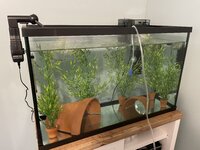 3CCF5AFE-3E6D-41C1-B581-94A923605128.jpeg3.4 MB · Views: 229
3CCF5AFE-3E6D-41C1-B581-94A923605128.jpeg3.4 MB · Views: 229 -
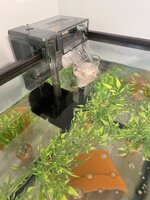 623BD860-C26D-4DF2-9336-7DB4D71DAEDA.jpeg1.8 MB · Views: 233
623BD860-C26D-4DF2-9336-7DB4D71DAEDA.jpeg1.8 MB · Views: 233 -
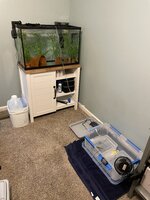 1804F5C0-347B-4A96-BAFC-397CAB82ABC1.jpeg2.3 MB · Views: 193
1804F5C0-347B-4A96-BAFC-397CAB82ABC1.jpeg2.3 MB · Views: 193 -
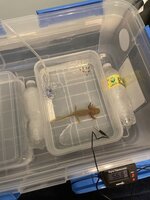 0D24D23E-D103-4071-89A0-9C7C89E151DD.jpeg1.5 MB · Views: 246
0D24D23E-D103-4071-89A0-9C7C89E151DD.jpeg1.5 MB · Views: 246 -
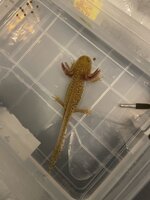 3F38AE73-D7AF-4866-B540-F2356EDDF596.jpeg1.5 MB · Views: 278
3F38AE73-D7AF-4866-B540-F2356EDDF596.jpeg1.5 MB · Views: 278

